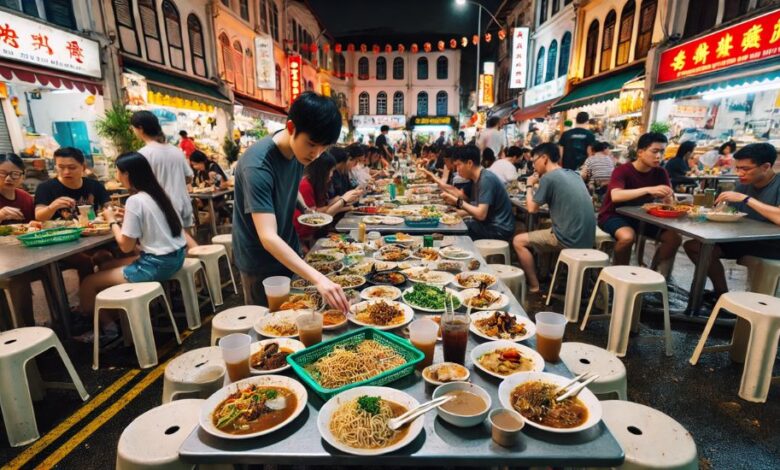Chinatown Hawker Leftovers Consumption: A Deep Dive into Culture, Sustainability, and Ethics

Before diving into the specifics of leftovers, it is essential to understand the hawker culture itself. Hawker centers are communal food courts predominantly found in Southeast Asia, where skilled vendors prepare and serve a wide range of affordable dishes, from noodle soups and stir-fried rice to dumplings and desserts. In Chinatowns worldwide, these centers represent a melting pot of flavors and culinary traditions, offering patrons a unique dining experience that blends tradition with innovation.
The Concept of Chinatown Hawker Leftovers Consumption
Chinatown hawker leftovers consumption refers to the act of collecting and consuming food that has been left behind by diners at hawker centers, particularly in Chinatown districts. This practice, though controversial, raises various cultural, economic, and environmental considerations. While some view it as a means of reducing food waste and addressing food insecurity, others see it as an issue related to hygiene and dignity.
The Historical and Cultural Perspective
In many Asian societies, the notion of frugality and maximizing food usage is deeply ingrained. Historically, food scarcity during periods of economic hardship led people to minimize waste, and repurposing leftovers became a survival strategy. In modern times, some individuals, particularly the elderly or those in need, may collect uneaten food from hawker center tables to consume later. This phenomenon is particularly noticeable in Chinatown hawker centers, where traditional values often intersect with modern challenges.
Economic and Social Implications
For some individuals, Chinatown hawker leftovers consumption is a way to manage financial difficulties. The rising cost of living has made it harder for lower-income individuals to afford meals, and leftover food provides an alternative source of nourishment. However, this practice also brings up ethical concerns—should society be doing more to support vulnerable populations so they do not have to resort to consuming discarded food? The debate extends beyond food consumption into broader discussions about wealth disparity and social support systems.
Environmental Impact and Sustainability
Food waste is a global concern, and Chinatown hawker leftovers consumption highlights the importance of sustainability. Every day, tons of edible food are discarded at hawker centers, contributing to environmental issues like landfill overflow and greenhouse gas emissions. Some argue that reusing leftovers aligns with sustainability efforts by reducing food waste and making full use of available resources. However, effective solutions such as organized food redistribution programs may be necessary to ensure that leftover food is handled in a safe and structured manner.
Hygiene and Health Concerns
One of the biggest concerns surrounding Chinatown hawker leftovers consumption is hygiene. Unlike packaged or properly stored food, leftovers that have been exposed to air, handling, and possibly contamination pose significant health risks. Bacteria and pathogens can quickly multiply on unfinished meals, leading to foodborne illnesses. Public health experts caution against consuming food left on communal tables, as there are no guarantees regarding the conditions under which it was left behind.
Ethical Considerations and Public Perception
The ethics of Chinatown hawker leftovers consumption spark debates on dignity, choice, and social responsibility. While some individuals voluntarily consume leftovers out of necessity, others may do so as a lifestyle choice to protest food waste. Public perception varies—some view it as a necessary act of survival, while others see it as an undignified consequence of economic hardship. Raising awareness about food redistribution programs and community support initiatives could provide more ethical alternatives to this practice.
Addressing the Issue: Potential Solutions
To address the complexities of Chinatown hawker leftovers consumption, a multi-faceted approach is needed:
- Community Fridges and Redistribution Programs – Establishing community food-sharing initiatives can help redirect edible surplus food to those in need.
- Government and NGO Involvement – Policies and organizations can help bridge the gap between excess food production and those who require assistance.
- Hygiene Education and Awareness – Educating the public about the risks of consuming exposed leftovers can promote better food safety practices.
- Encouraging Portion Control and Mindful Consumption – Diners can be encouraged to take only what they can finish, reducing overall food waste.
- Corporate and Business Contributions – Hawker centers and restaurants can participate in surplus food donation programs to repurpose excess food safely.
The Future of Chinatown Hawker Leftovers Consumption
As urbanization and economic disparities continue to shape communities, the issue of Chinatown hawker leftovers consumption will remain relevant. With growing awareness of food waste and sustainability, cities may adopt innovative solutions to tackle the problem in a humane and efficient manner. Whether through policy changes, technological advancements in food preservation, or stronger community support systems, the goal should be to create a balance between reducing food waste and maintaining dignity for all individuals involved.
Conclusion
Chinatown hawker leftovers consumption is a multifaceted issue that intertwines cultural traditions, economic realities, environmental concerns, and ethical dilemmas. While some individuals see it as a practical solution to food waste, others question its implications on hygiene and dignity. As society moves forward, it is crucial to find sustainable and ethical ways to address food security and waste management while respecting the dignity of those affected.



